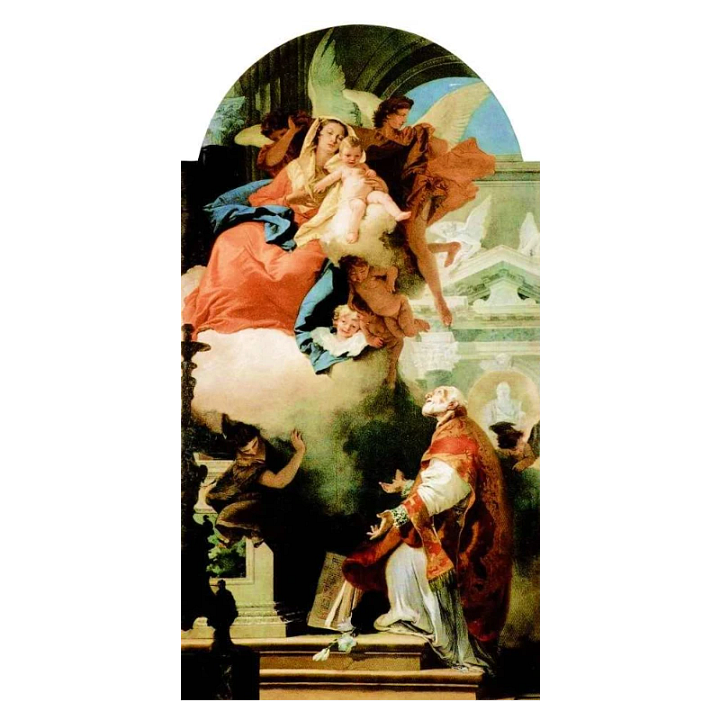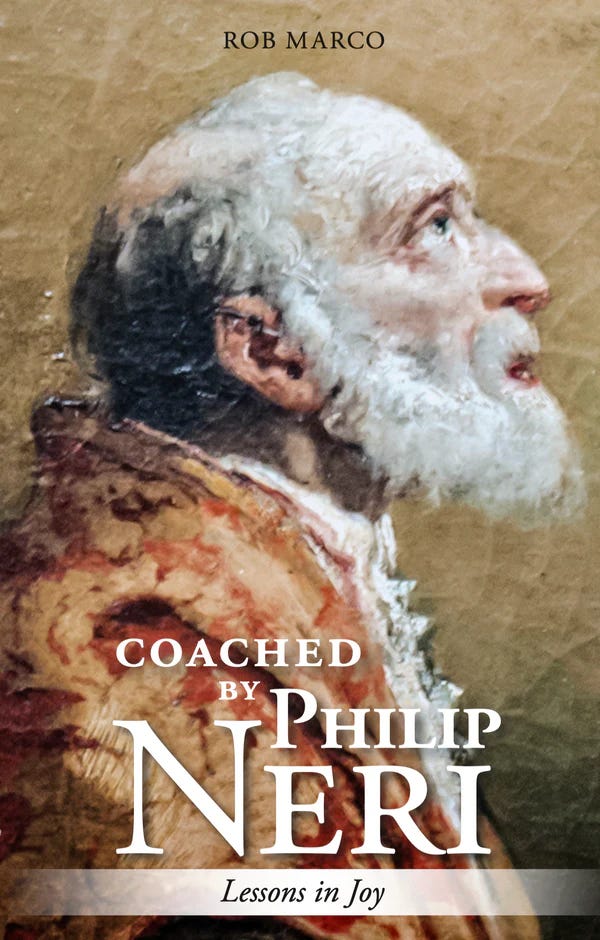A friend of mine once said his favorite saint was Philip Neri because the famed Apostle of Rome once told the gloomy St. Charles Borromeo to “lighten up a bit”. That’s my kind of saint too!
If you were to bump into Philip Neri on a street corner, you would immediately like him because he was the kind of guy who always had a smile, a disarming sense of humor, and a kindly demeanor.
He would probably strike up a conversation with you at the drop of a hat and the conversation would be informed and interesting because he was also a smart man and had an innate love for people.
In a nation of extroverts (Italy!), Philip must have been their extroversion Olympic gold medal winner. It was just who he was. Even as a child, he was so good-natured that everyone called him Pippo Buono, good little Phillip!
A Missionary
He was born to a noble family in Florence in 1515 AD, and that spark of nobility received extra oxygen through some fiery graces that ultimately led him to his vocation as a priest—yet, not right away. He was, by temperament and personality, a missionary with an innate enthusiasm to spread his goodness everywhere.
The spiritual fire was kindled by a mystical vision of Jesus when Philip was 18 years old. The vision gave him his calling to draw others into that fire and determined the direction of his life from there on out.
He was living in Naples with an uncle whose business and fortune he was set to inherit, but after his mystical vision, Philip lost all taste for worldly things and decided to become a missionary—to Rome of all places.
He went there as a sort of freelance do-gooder. But it was a providential move because he never left the Eternal City, and he never stopped doing good.
A Man of His Time
This was Rome in the middle of the Renaissance era. Growing up, he would have heard of the wonders of Botticelli, Raphael, and Leonardo and seen their works in Florentine churches.
Living at the same time as Michelangelo, Titian, and Tintoretto, he likely saw their masterpieces fresh off the artist’s easel and perhaps even witnessed Michelangelo painting the ceiling of the Sistine Chapel.
His long life (80 years) spanned the papacies of 15 popes and witnessed the construction of the new St. Peter’s Basilica, which was both a glorious event and a cause of contention due to its expense and financing.
He certainly knew of that troublemaker, Martin Luther, way off in Germany and easily understood that a person like Martin Luther could arise in the Church only when its human corruption had reached such a level that rebellion would break out.
It was all true, of course, but human faults and failings didn’t seem to bother Philip Neri. For 17 years as a layman, he went about Rome, as all good missionaries do, with a burning concern for the salvation of souls. His life’s work was not Church governance. It was human and spiritual influence. And he was a master at it.
His plan was simple: to meet people where they were and invite them to be where God wanted them to be. In Rome he went out to the plazas, the street corners, the bars and gathering places, and he spoke of God and the sacraments as the sources of sanctification. His motto was
"A joyful heart is more easily made perfect than a downcast one."
He lived that way with a playful good humor and wit. He often asked his companions: "Well, brothers, when shall we begin to do good?" That is the question and the burning concern of a saint.
Means of Evangelization
In those long years of apostolate he established traditions that brought thousands of people into the Church and back to the practice of their faith by simple and straightforward means of touching their souls.
· He visited hospitals and care homes incessantly;
· He tutored kids and conducted an outreach to the youth of the city;
· He sponsored pilgrimages to holy sites, whole day events which included picnics and music (though he himself reputedly couldn’t carry a tune!)
· He constantly gave retreats (in this he was influenced by his friend, St. Ignatius Loyola who also lived in Rome at the time);
· And above all, he was renowned for his love for the Eucharist and the Forty Hours Devotion to the Blessed Sacrament.
What a persuasive man he must have been! It is said he was constantly surrounded by crowds of people.
A Walking Miracle
This was eventually the reason St. Philip decided to become a priest. He knew that even his winning personality was not enough to convert people from their sinful ways. He needed the help of a spiritual power that would exponentially multiply his good works.
That power was in the Church and in the Sacraments, especially the Holy Eucharist and Confession. As a priest, he curtailed none of the other activities he initiated as a layman but added several hours of confessions per day—amazing!
In that, I gather that he must have been kind of like the Padre Pio of his time (but much more patient than the 20th century Franciscan!) Amazing and miraculous things always seemed to happen around him.
Like Padre Pio, he would often tell people their sins when they neglected or forgot them in the confessional. He once converted a young nobleman by giving him a vision of hell. Whoa!
At one point in this life he thought God was calling him to go on the overseas missions like St. Francis Xavier, but he had a vision of St. John the Baptist who told him to stay put because Rome needed more reform than anyone in the mission field!
Numerous times, especially as he got older, he himself was healed of significant illnesses by receiving the Eucharist and the Anointing of the Sick, and he admitted that the Virgin Mary visited him and healed him numerous other times.
He usually went into ecstasies during his celebration of Mass—in fact, his Masses often lasted over two hours!


Holy Influence
St. Phillip was one of those men who “walked with kings yet kept the common touch” as the saying goes. He was consulted by many saints, popes, cardinals, and statesmen of his day, but he never ceased to give himself to the common people he served.
He founded two devotional confraternities for laymen and a religious order of priests called the Congregation of the Oratory which still thrives today in many countries. Its most celebrated member was St. John Henry Cardinal Newman.
And here’s a final fun fact about the man that is a bit surprising: St. Philip Neri is the Patron Saint of the US Special Forces. Why? According to one website: “He was chosen … because he embodied the qualities essential to an ideal Special Forces Soldier: selflessness, exceptional teaching skills, and inspirational leadership.”
I think the Army is on to something there. If we imagine St. Philip Neri as a soldier in the Church Militant, we might call him a “happy warrior.”
Many people see what’s wrong with the Church and the world and react in a purely human way by complaining or criticizing. We’ve all been there, done that. But St. Philip saw all these things too and reacted in a creative and saintly way by building up people’s spirits and strengthening their souls with grace and joy.
He knew the secret: People with transformed souls are the ones who carry out reforms of Church and society in every age. And who couldn’t benefit from a little more joy in their life?!
(Feast Day of St. Philip Neri, May 26th, tomorrow!)
---
I would just like to add a note about a friend of mine, Rob Marco, whose book on St. Philip Neri will be published by Scepter Press in a few weeks! That was wonderful news to me, and I hope that our Sacred Windows readers will support this wonderful effort and great author. (Click image to go to Scepter Press for pre-ordering.)
—-
Sources: Catholic Online; New Advent (Catholic Encyclopedia). Images by Pixabay and Wikimedia: Giovanni Battista Tiepolo; Sebastiano Conca; Giuseppe Passeri (public domain); Feature: Saints Reredos (Michael Garlick).










Thank you for this beautiful story about a wonderful man who can inspire us .
An amazing saint, especially being named he patron saint of the US Special Forces. This is good timing reading his story as tomorrow is his big celebration day.